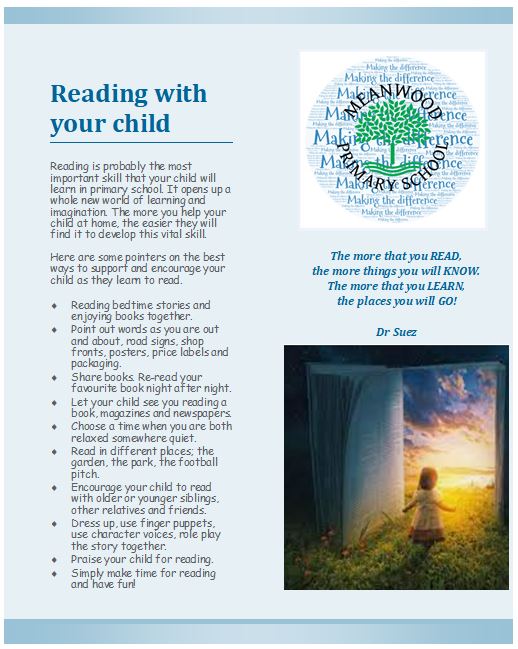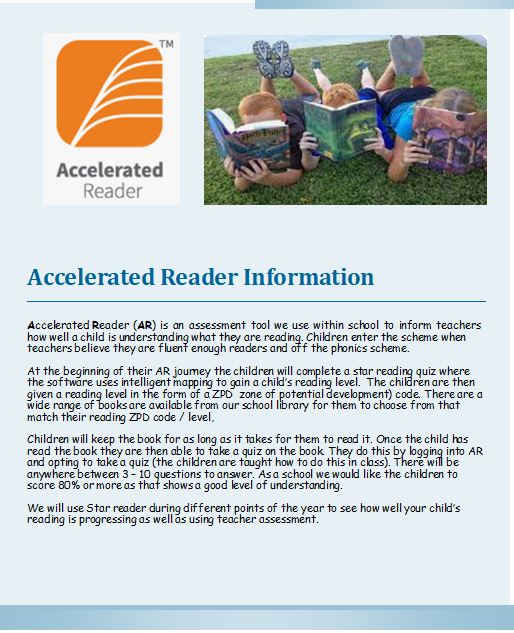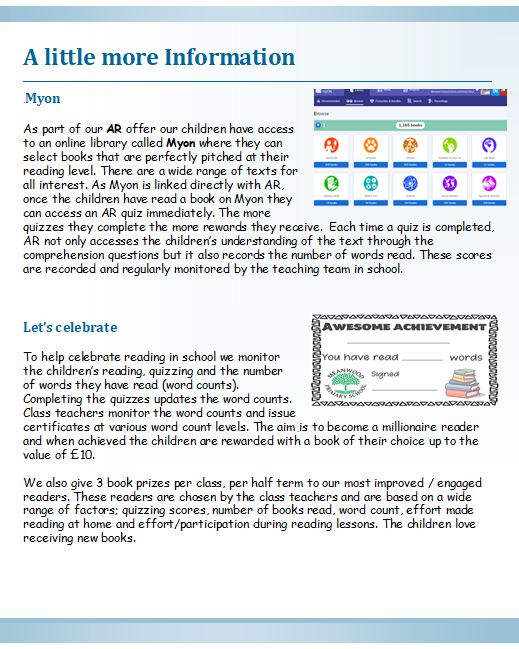Reading at Meanwood
Intent
At Meanwood Primary School, we value reading as a key life skill and are committed to providing children with a literacy rich environment, high quality texts and inspiring learning opportunities. For our children to unlock the whole of the academic curriculum we believe it is essential they become proficient readers.
We aim for all children to:
- Gain a lifelong enjoyment of reading and books
- Read accurately, fluently with expression and confidence
- Be able to respond to a variety of different texts
- Develop a deeper understanding of story language and vocabulary
- Enable them to explore new environments, cultures and people beyond their own experience
Reading - EYFS – Year 2
We have adopted the Read Write Inc (RWI) phonics programme as our basis for the teaching and learning of reading in EYFS and Key Stage 1:
- RWI teaches children to form each letter, spell correctly, and compose their ideas step by step.
- In RWI phonics lessons, children learn to read accurately and fluently with good comprehension.
- They rapidly learn sounds and the letter, or groups of letters, they need to represent them. This knowledge is taught and consolidated every day.
- Children read the story three times. On the first read, children focus on accurate word reading. On the second read they develop fluency and on the third read they focus on comprehension. Fluency and comprehension increase with each repeated reading.
- They practise handwriting every day: sitting at a table comfortably, they learn correct letter formation and how to join letters speedily and legibly.
Supporting Your Child's Reading
Although your child will be taught to read at school, you can have a huge impact on their reading journey by continuing their practise at home. There are TWO types of books your children will bring home.
- A phonics reading practice book: this has been carefully matched to your child's current reading level. If your child is reading it with little help, please do not worry that it's too easy - your child needs to develop fluency and confidence in reading. Listen to them read the book. Remember to give them lots of praise - celebrate their success! If they can't read a word, read it to them. When they have finished, talk about the book together.
- A library sharing book: In order to encourage your child to become a lifelong learner, it is important that they learn to read for pleasure. The sharing book is a book they have chosen for you to enjoy together. Please remember that you shouldn't expect them to read this on their own. Read it to or with them. Discuss the pictures, enjoy the story, predict what might happen next, use different voices for characters, explore the facts in the non-fiction books. The main thing is you have fun together!
For further information please see our RWI information PPT or the RWI website Ruth Miskin | Parents/Carers.
Reading - Year 3 – Year 6
Children in year 3-6, and from the Summer term in year 2 children continue to be supported with developing their fluency , accuracy and stamina as well as the progression of comprehension skills.
Reading is taught in 3-5 weekly sessions of between 30 and 45 minutes each. These sessions are taught as whole class reading sessions. These lessons consist of;
- A vocabulary lesson- pre-teaching key vocab
- Oral comprehension lessons
- Written comprehension lessons
Each lesson starts with a 10-minute fluency focus to ensure children read as accurately and fluently as possible.
Texts chosen for the reading lessons are progressive across school in line with the Accelerated Reader programme which is used when children complete the phonics programme in Y2. Books selected for lessons include a classic text, a modern text, one from a series of books and one from an author to be studied.
Accelerated Reader
Alongside our reading lessons we also use Accelerated reader which is a reading assessment tool. Following completion of an assessment quiz children are given a reading range which links to their reading ability. They can read a physical book or one found online within MYon, they then complete a short online comprehension quiz which leads to points and progress rewards.
For further information please see our AR/MYon user guides/parent information booklet and the website links for MYon AR:
Supporting Your Child's Reading
Although your child will be taught to read at school, you can have a huge impact on their reading journey by continuing their practice at home. We recommend children read for 20 minutes per day at home and complete the online quizzes linked to the books they have read. The more they read, the more they know!
Story Time
From Reception to Year 6, each class has whole story times woven into their timetables. During these slots chosen texts are read/ shared by class teachers. These carefully chosen texts are aimed to develop the range of texts children are exposed to, increase children’s knowledge of authors and inspire wider reading.
Independent Reading Time
From Year 3-6 each class has three 15 - minute independent reading slots in their weekly timetable. This allows children extra time to read in class with the support of an adult if required.
Love to Read Boxes
In a bid to promote reading at home we have created our love to read boxes. These boxes go home on a Friday, with a chosen child, along with a book of their choice and should be returned to school the following Wednesday. These boxes contain a reading journal where children are encouraged to write a review of the book they have to read. The children then share their book review with their classmates. These boxes also contain a lovely little treat to be shared, in a cosy place at home, with someone whom they enjoy reading with.
We Love a Good Library
At Meanwood we have been working hard to improve our library areas. We now have library’s in both our KS1 and KS2 buildings. The libraries contain Accelerated reader books, key authors and we are busy building some year group displays to celebrate texts we have enjoyed. Both libraries have school librarians who are responsible for the general up keep and tidiness of the library, they enjoy the responsibility and are celebrated on our reading displays in school.
Each classroom across school has a dedicated reading area with a selection of texts/ genre all aimed specifically at that year group.
As we love to read at Meanwood, our KS2 Library is opened at lunch times daily for our KS2 children to enjoy. This is supervised by our dedicated staff who volunteer their lunchtimes to read with the children.
Due to the determination and fund raising of our previous year 6 children we now have a fully equipped story shed within our KS1 playground for our Year 1 and 2 children to enjoy. This is also open during lunchtime supported by dedicated staff and our year 6 children who volunteer some of their own lunchtime to read with our younger children.
To encourage our children further, we regularly visit Spotland Library on Ings Lane. During our visits the children enjoy looking at and sharing books with each other. We also choose a book each to bring back to school to read which we then return upon our next visit. We encourage our families to join our local library too so if you are interested please pop in, they are extremely welcoming and will be pleased to see you.
Celebrating Reading
At Meanwood there are a number of ways we like to celebrate reading.
At the end of every half term three children are chosen from each class to receive a book prize. These children are chosen by the class teacher and are rewarded for a variety of reasons. These could be:
- Fluency results
- Improved word count
- Quizzes taken and scores
- Input / participation in reading lessons
- Pupil attitude / voice / effort within class
- The children choose their own book prize from a variety of available texts.
For the children who are accessing Accelerated Reader (from Year 2 – Year 6) the children are issued with Word Count certificates celebrating the number of words they have read. The aim is become a millionaire reader, a reader who has read one million words. Each time this is achieved the successful child can choose a book up to the value of £10.00 and school will order it and pay for it. These children are also celebrated on our reading display in school.




.png)